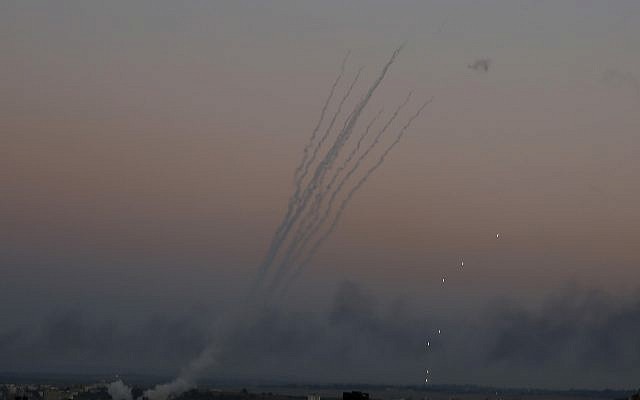TV news cites Palestinian source familiar with investigation of deadly gun battle that led to escalation as saying operatives rented an apartment and handed out medical equipment
An Israel Defense Forces special unit, which last month fought its way out of the Gaza Strip in a deadly gun battle after being discovered by Hamas security personnel, had been operating inside the Palestinian enclave for weeks, Hadashot television news reported on Wednesday.
The Israeli team rented an apartment and was posing under the cover of workers in a non-government medical equipment charity, “Bamasa,” which has two branches, one in Khan Younis and one in Gaza City, according to a Palestinian source familiar with the Hamas investigation into the incident cited by Hadashot.
The Times of Israel could not independently confirm the existence of a charity by that name.
On the night of November 11, the Israeli unit was exposed inside the southern Gaza city of Khan Younis following a search of their vehicle at a Hamas checkpoint, resulting in a firefight in which an Israeli lieutenant colonel was killed, along with seven Palestinian gunmen. “Something out of the ordinary” about those in the vehicle prompted Hamas suspicions, the Hadashot TV report said.
After the special forces operation and subsequent gun battle, Hamas and the Iran-backed Palestinian Islamic Jihad terror group launched the largest-ever bombardment against Israel from the Gaza Strip, lobbing some 500 rockets and mortar shells mostly at Israeli communities surrounding the coastal enclave — pushing Israel and terror groups to the brink of war.
It was entirely by chance that the force was discovered, Hadashot reported. Until the clash Hamas had no suspicions regarding the workers.
According to a report Monday in the Independent newspaper, the Israeli troops used “detailed but fake” identity cards with the names and personal information of Palestinians living in the Gaza Strip.
“Those who the Israelis were posing as were detained but they had no idea their names had been used,” Hazem Qassem, a Hamas spokesman, told the British paper from Gaza City. The Palestinians whose names were found to have been used by the Israeli special forces were later released, he said.
Palestinian officials have claimed the Israeli troops were installing surveillance equipment in the Gaza Strip in order to listen in on Hamas’s internal communications.
Most details of the operation remain under a strict gag order by the military censor.
The Independent acknowledged that it was unable to corroborate much of the information provided by the Hamas officials about the Israeli raid. The Israel Defense Forces has confirmed that special forces soldiers conducted an operation on the night in question but would not provide any details besides that it was of great importance to national security.
On the night of of the incident, the troops were stopped at a Hamas checkpoint and questioned. During their interrogation, the Hamas gunmen noticed that the alleged Israeli soldiers’ accents did not match the addresses listed on their ID cards.
“They told the fighters at the checkpoint that they were delivering patients back from clinics to their homes and had a wheelchair in the back of the van. They presented their ID cards but the [fighters] manning the checkpoint were suspicious as their accents and voices did not match the areas where they said they were from,” a Hamas official said.
According to the Palestinian officials, when a more senior Hamas commander decided to bring in the suspects for additional questioning, the Israeli special forces soldiers opened fire, killing the senior commander, Nour Barakeh, and his deputy.
During the firefight and dash to the border, the Israeli lieutenant colonel — who can only be identified by the first Hebrew letter of his name, “Mem” — was killed and another officer was wounded. Five other Palestinian gunmen were also killed.
Since the raid, Hamas officials have released details about the operation to the public, apparently in an attempt to fish for additional information about the nature of the Israeli operation and potentially in order to embarrass the IDF.
Last month, Hamas published the photographs of eight suspected Israeli special forces soldiers, calling on members of the public to contact its military wing if they had any information about them and their activities.
Though freely available on the internet, the photographs could not be published by Israeli media by order of the military censor.
In a highly irregular public statement, the censor also called on Israelis not to share any information they have about the raid, even if they think it benign.
The IDF has launched two investigations into the raid.
Judah Ari Gross contributed to this report.






Leave a Reply
You must be logged in to post a comment.